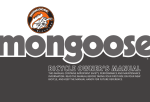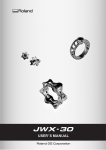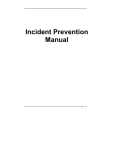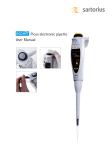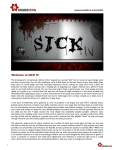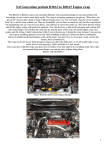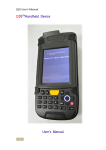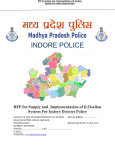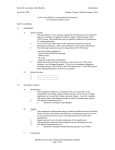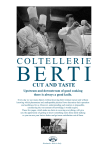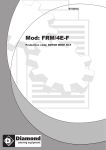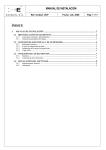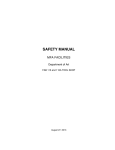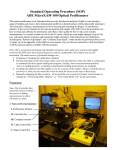Download Laboratory Safety Instructions (ME Laboratory Committee)
Transcript
Northern Border University College of Engineering Department of mechanical Engineering Laboratory Safety Instructions (ME Laboratory Committee) Safe laboratory practice is an attitude, a knowledge, and an awareness of potential hazards. Safety is a mutual responsibility and requires the full cooperation of everyone in the laboratory. This cooperation means that each student, instructor, and researcher must observe safety precautions and procedures The main purpose of this manual is to help you, the student, attain the objectives of the Mechanical Engineering Laboratory courses by safety ways. The objectives of the Mechanical Engineering Laboratory courses are: a) To let you apply, in the laboratory, the theoretical knowledge that you acquired in the classroom about physical principles, testing methods, and test equipment. b) To let you develop a good laboratory technique. c) To let you acquire the facility to write mechanical engineering laboratory reports. These objectives are equally important. Some of the laboratory activities by which you will attain these objectives are: by determining, experimentally, physical performance characteristics and standard values described in textbooks and handbooks, by consulting various sources of testing and operating standards, by planning laboratory work for achieving the greatest efficiency, and obtaining the best possible results, by presenting the laboratory results in the form of Mechanical Engineering Laboratory Reports. Two main parts in this mechanical engineering manual, Northern Border University are included. The first Part is about the safety rules and the second one is included the most important information about our Laboratories and shops. 1. SAFETY RULES AND SUGGESTIONS Safety is a very important part of every engineer's job! Safety is not only a concern of the engineer during the conceptual development of a design, but also when a design is finally implemented and when it goes into service. The following safety rules are in common use and are recommended for your serious consideration. Failure to observe safe laboratory Northern Border University College of Engineering Department of mechanical Engineering practices will be sufficient cause for immediate dismissal from the laboratory course with an "F" grade. In this section more details about some important safety knowledge will be presented 1. Emergencies and First Aid 2. Safety Rules 3. Fire Safety 4. Electrical Safety 5. Radiation Hazard 1. EMERGENCIES AND FIRST AID In a medical emergency, summon professional medical attention immediately. Provide first aid within the scope of your training while waiting for professional help to arrive. Be prepared to describe accurately the nature of the accident. 1.1 Emergency Equipment Everyone working in the Department labs must know how to use emergency equipment such as fire extinguishers, spill kits, safety showers, and eye wash apparatus. Know where these items are located in your laboratories. 1.2 First Aid There are certain injuries in which time is so important that treatment must be started immediately. Stoppage of Breathing. For stoppage of breathing from electrical shock or asphyxiation, the mouth-to-mouth method of resuscitation is far superior to any other known method. (a) Check mouth and throat for obstructions. (b) Rescue breathing must be started at once. Seconds count! (c) Do not look around or look for help. Severe Bleeding. Severe bleeding can almost always be controlled by firm and direct pressure on the wound with a pad or cloth. The cleaner the cloth, the more desirable. In an emergency, use part of the clothing. (a) Wrap the injured person to avoid shock, and call immediately for medical attention. (b) Raise the bleeding part higher than the rest of the body. (c) Keep victim lying down. (d) Never use a tourniquet. Thermal Burns. If the burn is minor, apply ice or cold water. Northern Border University College of Engineering Department of mechanical Engineering In case of a clothing fire: (a) The victim should drop to the floor and roll, not run to a safety shower. A fire blanket, if nearby should be used to smother the flames. (b) After flames are extinguished, deluge the injured person under a safety shower, removing any clothing contaminated with chemicals. (c) Keep the water running on the injured for 15 minutes to remove heat and to wash off chemicals. (d) Place clean, soaking wet, ice-packed cloths on burned areas, and wrap to avoid shock and exposure. (e) Do not use a carbon dioxide fire extinguisher on a person with burning clothing; this could cause suffocation or frost-bite. Dry chemical extinguishers will create inhalation hazards and contaminate wounds. Pressurized water can aggravate burn injuries. Chemical Burns. (a) For chemical burns or splashes, immediately flush with water. (b) Apply a stream of water while removing any clothing that may have been saturated with the chemical. (c) If the splash is in the eye, flush it gently for at least ten minutes with clear water. Wash in a direction away from the other eye. (d) If the splash is on the body, flood it with plenty of running water. (e) A shower, hose or faucet should be used in an emergency. (f) For chemicals spilled over a large area, quickly remove contaminated clothing while using the safety shower; treat as directed under large Thermal Burns. Seconds count, therefore, no time should be wasted simply for modesty. 2. SAFETY RULES 2.1 General 1. An individual is advised to work only under conditions in which appropriate emergency aid is available when needed. Work when others are around to provide help if it is needed. 2. Do not work in a laboratory wearing loose hair, loose clothing or dangling jewelry. 3. Wear shoes to protect your feet. 4. Protect your eyes. In all laboratories where chemicals are used, there is the hazard of splashes or dust particles entering the eyes. Pressurized or vacuum vessels may explode or implode sending shrapnel through the laboratory. 5. Protect your ears. The healthy ear can detect sounds ranging from 15 to 20,000 Hz. Temporatory exposure to high noise levels will produce a temporatory hearing loss. Long term exposure to high noise levels produces permanent hearing loss. There appears to be no Northern Border University College of Engineering Department of mechanical Engineering hearing hazard (although possible psychological effects) to noise exposures below 80 dB. Exposure above 130 dB is hazardous and should be avoided. 6. Use respirators when necessary. 2.2 Laboratory Practice 1. All containers must be labeled, including such harmless items as distilled water. The label should contain the proper name of the chemical and, if appropriate, a statement of hazards (with the most severe first), precautions, date of purchases or synthesis, and the nature of the user or laboratory. 2. Do not use chemicals from unlabeled containers. The need for adequate labeling extends beyond the immediate requirements of the individual users, since they may not be present in case of fire or explosion, or when containers are broken or spilled. Also, they may no longer be associated with the laboratory years later when containers have deteriorated or have otherwise lost their value. 3. Do not pipet by mouth. 4. Clean spills promptly, especially mercury, oils, etc. 5. Items that might cause thermal burns should not be left unattended if not labeled with a warning. 2.3 Glassware 1. Use only Pyrex or shatterproof glassware. 2. Never use cracked or chipped glassware. 3. Insert tubing properly into stoppers (i.e., use lubricants, hand protection). 2.4 Equipment 1. Before using an instrument or machine, be sure to know how to turn it off in case of emergency. 2. Check all electrical connections and mounting bolts before each use. 3. Check that all rotating parts are free to turn, and that there is no mechanical obstruction before operating. 4. Attach an emergency shutdown card to any piece of equipment left operating unattended outside normal working hours. This card should contain your phone number and all information that would be required by anyone who might be faced with the need to shut down the equipment. 5. Laboratory equipment is not to be placed in corridors. 2.5 Gas Cylinders 1. Secure gas cylinders with a strap or chain, whether or not they are in use. Northern Border University College of Engineering Department of mechanical Engineering 2. Transport gas cylinders with cap on, on a proper cart. 3. Do not use an open flame near gas cylinders. 4. Do not use grease on gauges or connections. 5. Before using gas in an experiment, be sure there are no leaks in the system. 6. Learn directions for closing and opening valves. (All main valves close clockwise.) 7. Do not use adaptors to connect regulators. Use only regulators specified for the particular gas. 3. FIRE SAFETY 3.1 Precautionary Procedures Know the location of fire exits, fire alarms and extinguishers. Fire extinguishers are primarily for use on fires in their incipient stages. Make it your business to learn about the proper use of fire extinguishers. Do not block access to fire escape routes. Neatness prevents many fires. Fire spreads much faster when it has cluttered waste materials to feed on. Oily rags, waste or papers improperly stored are important causes of spontaneous combination. Store these materials properly, e.g., in covered metal containers 3.2 Emergency Procedures If a fire starts, call for assistance by actuating the nearest fire alarm box and call the University Fire and Emergency number (911). Then, only if the fire is not large, confine and try to extinguish it with the available extinguishers. If there is no injury, and the fire is contained in a vessel, it can usually be suffocated by covering the vessel with an inverted beaker or watch glass. Do not use towels or clothes. Remove nearby flammable materials to avoid possible spread of fire. If the fire is over an area too large to be suffocated quickly and simply, abandon the fire. If evacuation is necessary, and if time allows, shut off power to any equipment. Shut off gas or other open flames. Turn off hot plates and main gas valve. If your clothes ignite, "stop, drop and roll", to smother the flames. Do not run; running only intensifies the flames. When fire blankets are readily available, use them to wrap around yourself to aid in putting out the fire. Exit from the building via staircases; do not take elevators. Remove any objects that may be obstacles in passageways or to fire doors. Do not return to the building unless permitted to do so by the Fire Department. 4. ELECTRICAL SAFETY Electricity is in constant use both within and outside the laboratory. With direct current, a person can detect a "tingling" feeling at about 1 mA and the median "let-go" threshold (the Northern Border University College of Engineering Department of mechanical Engineering current at which one cannot release the conductor) is about 76 mA. For 60 Hz alternating current, the values are about 0.4 mA and 16 mA, respectively. In general women are more sensitive to the effects of electrical current than men. Higher currents produce respiratory inhibition and ultimately cardiac arrest. Although minute electrical shocks are generally considered annoying rather than harmful, such shocks constitute an ominous warning of the presence of potentially hazardous conditions. The device in question should be disconnected immediately and the cause ascertained by a person competent in such manners. Work on electrical devices should be done only after the power has been shut off in such a manner that it cannot be turned on accidentally. Internal current-carrying devices such as capacitors must be discharged. It is important that all "home-made" electrical apparatus be inspected and approved by someone competent in electrical circuitry before being placed in service. The following are a list of rules for working with electrical equipment. Use only tools and equipment with non-conducting handles when working with electrical devices. All current transmitting parts of any electrical devices should be enclosed. When checking an operating circuit keep one hand either in pocket or behind back. Maintain a work space clear of extraneous material such as books, papers, and clothes. Never change wiring with circuit plugged into power source. Never plug leads into power source unless they are connected to an established circuit. Avoid contacting circuits with wet hands or wet materials. Check circuits for proper grounding with respect to the power source. Keep the use of extension cords to a minimum and cords as short as possible. Tie off excess cords out of pathways. Do not use or store highly flammable solvents near electrical equipment. Make certain that all electrical equipment is properly grounded. Be aware and alert of the dangers inherent in high voltage equipment. (Any system operating at voltages above 480 volts shall be considered a high voltage system and shall be serviced only by specially trained employees.) In the event of an electrical fire: Turn off the power source and unplug. Use carbon dioxide or dry chemical extinguisher or sand to put out the fire. Never use water. When the fire is extinguished, check the circuit to determine the cause. Do not turn on the circuit until the cause of the fire has been established and the fault corrected. Northern Border University College of Engineering Department of mechanical Engineering 5. RADIATION HAZARD A number of acute and long term effects on humans have been related to exposure from various types of ionizing radiation. Radiation hazards arises when using radio-isotopes, lasers, X-ray generators and plasma torches. Each is hazardous in a unique way. A thorough knowledge of the device or the isotope which is to be used is mandatory. The precautions vary widely. Information pertaining to the particular hazard should be obtained from the faculty or research staff member or technician in charge of the facility prior to use. However, several precautionary procedures should always be followed. Clearly mark areas in which lasers, radiation and ultraviolet or high intensity light sources are in use. Wear appropriate eye protection when working with these sources. Be aware and alert to radiation hazards when working in or visiting a laboratory where radiation is generated. If a container marked "Radioactive" is accidentally broken, do not attempt to clean it up. Call for assistance from Radiation Safety (277-2753) immediately or call Campus Police (911) on evenings or weekends. Northern Border University College of Engineering Department of mechanical Engineering NORTHERN BORDER UNIVERSITY College of Engineering Mechanical Engineering Department Northern Border University College of Engineering Department of mechanical Engineering MECHANICAL WORKSHOP MECHANICAL WORKSHOP SAFETY OPERATING PROCEDURES Safety Equipment Available for All Users Machine Tools Safety Glasses (3 times per quarter after that, you must supply your own.) Face Shields Welding DO Glasses/Goggles/Face NOT use theseShields machines unless a teacher has instructed Gloves you in their safe use and operations and has given Ear Plugs/Ear Muffs permission. Dust and Particle Masks Safety glasses must be worn at all times in work areas. Appropriate footwear with substantial uppers must be worn. Long and loose hair must be contained. Close fitting/protective clothing must be worn. Rings and jewellery must not be worn. Hearing protection must be worn when using this machine. Specific Equipment Safety Welding Equipment For assistance in setting up the welding equipment ask a Tech. Wear the proper shade of eye protection for the process that you observe-ask if in doubt! Shade 5 is for brazing, Oxy-Acetylene welding, flame cutting or Plasma cutting. Shade 10 is for MIG and TIG welding. Protect your skin from the UV radiation of the arc. Wear long sleeves, gloves, etc. Protect others from being exposed to the arc with the welding screens. Quench hot materials in water or oil or mark them with the word “HOT” if air- cooling. Pass your hand above materials to check if they’re HOT before you touch them. Do all welding in the welding area if at all possible. Shields and fire hazard precautions will need special attention if welding in other areas. Check for adequate ventilation before welding. Welding on zinc plated (galvanized) metals is hazardous to your health (it makes a POISON GAS) and can be fatal. NEVER weld on zinc plated metal, painted or coated materials! Gas (Oxy-Acetylene) Welding Gas cylinders must always be secured to a solid structure with a chain or other suitable device as a protection against falling or rolling. Keep the welding equipment free of oil and grease, and away from oily rags. When oil comes in contact with oxygen it will explode! Northern Border University College of Engineering Department of mechanical Engineering Check for adequate ventilation before welding. Keep ALL flammable material away from the work area. Wear the appropriate welding goggles (shade 5) and gloves. Assistants and observers must also wear shade 5 welding goggles. Release the regulator pressure screw and open the cylinders slowly. If leaks are detected in the equipment, shut all valves off and report it immediately to a Tech. Open the acetylene cylinder 1/2 turn maximum. The normal pressure setting for acetylene is 5 p.s.i. with a maximum of 15 p.s.i. Acetylene explodes above 15 p.s.i.! The oxygen cylinder valve should be opened all the way as it is a double seating valve. The normal pressure setting for oxygen is 10 p.s.i. with higher settings used for torch cutting. (Ask for assistance when flame cutting with the torch.) Point the torch away from yourself and observers before lighting it. Use a friction torch lighter (flint striker) to ignite the torch. Close the acetylene valve first if the torch backfires. Keep sparks and flames away from the gas cylinders and hoses. Never roll equipment over hoses or cords! Close both cylinder valves and then release the pressure from the lines when you have finished the job. Arc (Electric) Welding Adequate ventilation is needed in the welding area before beginning. Keep ALL flammable material away from the work area. Never roll equipment over hoses or cords! Wear the appropriate welding helmet (shade 10), long sleeves or leather apron, long pants and leather gloves (or cotton gloves if TIG welding). Assistants and observers must also wear shade 10 welding helmets. These are required to protect the welder and observers from eye and skin damage by the intense ultraviolet (UV) radiation that emanates from the arc. You are responsible for setting up the welding shields to protect others from the effects of the arcs’ UV radiation on their eyes and skin before you begin welding. The shields are to be erected across the entrance to the welding area if the welding is being done in the welding area. If the work piece cannot be brought into the welding area then the shields must completely encircle the welding being done. Welding on zinc plated (galvanized) metals is hazardous to your health (it’s a POISON) and can be fatal. NEVER weld on zinc-plated metal or on painted materials! Northern Border University College of Engineering Department of mechanical Engineering Machine Tools Lathe o o o o o Roll up loose sleeves and do not wear loose clothes such as sweaters, jackets with strings or neckties while operating the lathe. Be certain the work piece is set up securely and tightly when using chucks and collets. Remove the chuck key immediately after each use! If the lathe where accidentally activated while the chuck key was still in the chuck, the key could fly out and possibly cause serious injury or stay in and cause severe damage to the lathe. After you have chucked up your work piece and completed your tool setup, you must spin the chuck by hand to ensure that the jaws of the chuck and the work piece will not hit the carriage of the lathe or the tool rest. Keep hands on the controls or at your side while the lathe is running. Keep hands away from chips as they are very sharp and possibly hot. Complete cuts that are close to the chuck or against a shoulder by hand feeding to prevent machinery or work piece damage. Remove the tool holder and tool post before filing or polishing. use only files with handles on the "tangs." Never move the speed selector controls while the spindle is rotating. Never push the reverse switch while a chuck is moving forward as this could cause the chuck to unscrew itself and fall off and cause serious injury. Regulate the depth of a cut and the machine speed according to the size and type of material. Chips should look like the number "9." If metal chips are wire-shaped, long and stringy, you should take a deeper cut and use a courser feed. Never try to remove a mass of chips while the machine is running. They can cause loss of fingers or pull you into the machine! Use tools that are properly ground for the particular job You may never check measurements or surface finishes of the work piece while it is spinning. When you turn between centers: Use the safety dog to drive work piece Clamp the tailstock securely. Use only a live center. When turning with a chuck and faceplate: Counterbalance work piece on the faceplate if it is irregular in shape. Stand away from the revolving faceplate to avoid being hit by flying objects. Northern Border University College of Engineering Department of mechanical Engineering Milling Machine The milling machine is a precision piece of equipment. Its table is not a workbench or a place to put tools. Keep hands away from chips as they are very sharp and possibly hot. Keep hands on the controls or at your side while the mill is running. Roll up loose sleeves and do not wear loose clothes such as sweaters, jackets with strings, or neckties while operating the mill. Secure the work piece firmly in the vice or with appropriate claps. Hold round stock securely with a "vee block" in a vise. Be certain both the work piece and the tool are set up securely and tightly when using vises, chucks, and collets. Remove all chuck keys and wrenches from the Quill or from tooling immediately after each use! If the mill were accidentally activated while the chuck key or wrench as still in the chuck or tooling, it could fly out and possibly cause serious injury or stay in and cause severe damage to the mill. Be sure you know how to use the switch and brake to stop the milling machine quickly before operating the machine. Be sure the power feed controls are in their "neutral" position BEFORE turning on the machine. Handle cutters carefully. They are sharp and can easily cut you. Use a soft hammer or mallet to seat the work piece against the parallel bars or bottom of the vice. Check the work piece, milling machine table, and holding device for clearance of the quill during the cutting. Set the machine for the proper depth of cut. Select the correct spindle speed for the type of material and the cutter being used. Select the proper direction of rotation for the cutter. Feed the work piece against or opposite the direction of rotation of the cutter. Never try to feel the finished surface while the cut is being taken with the mill. Always wear a face shield when performing fly-cutting operations. Regulate the depth of cut and the machine speed according to the size and type of material. Chips should look like a number "9." If metal chips are wire-shaped, long, and stringy, you should take a deeper cut and use a coarser feed. Never try to remove a mass of chips while the machine is running. They can cause loss of fingers or pull you into the machine! You are responsible for insuring that your use of air tools does not injure others. (i.e. do not blow chips towards someone, LOOK FIRST! Northern Border University College of Engineering Department of mechanical Engineering Drill Press: Use a center punch to help locate the hole to be drilled in the correct place. Select the correct speed for the material and size drill being used. Remove the chuck key immediately after tightening or removing a drill! leaving it in creates a high risk of injury or damage. All work must be held securely for drilling by using either a drill vise or C-clamps. A work-piece that moves when being drilled can break the drill, injure the operator and destroy itself. Don’t drill into the vise or table. Use wood under “through” holes. Hold round stock securely with a “Vee block” in a vise. Large work-pieces must be set firmly against the left side of the drill press column so that if the drill grabs, it cannot spin the work-piece and cause injury to the operator or others. If the drill grabs the work piece and it is yanked loose of the clamps and begins to spin, maintain downward pressure with the press and turn off the power. Do not retract the drill as this would allow the work-piece to be thrown from the press and may cause serious injury. Hands are to be kept clear of the revolving spindle, chuck, drill and chips. Always ease up on the feed or drill pressure as the drill begins to break through the workpiece. Heavy feed pressure will cause the drill to dig in, and could damage the material being drilled, break the drill, or cause the work-piece to spin. Drilling soft materials such as brass, cooper, or plastic is done with a drill ground differently than drills used for steel. When drilling large holes drill a pilot hole with a small drill such as 1/8 inch and then step up in sizes to prevent drill chatter. Be sure the drill press is stopped before removing the work-piece, or clearing chips or cuttings. Grinding Machine Grinding Safety Rules 1. Abrasive wheel machinery shall not be operated without the appropriate guards in place. 2. Tool rests on bench or pedestal grinders shall be set no more than 1/8 inch from thewheel. 3. Never use a wheel that has been dropped or has received a heavy blow, even through there may be no apparent damage. Such wheels may have internal fractures and will explode upon startup. 4. Stand to one side when starting machine. 5. Do not grind on the side of the wheel unless wheel is specifically designed for such use. 6. Do not use excessive pressure while grinding. Do not exceed .0005 inch down-feed at any time on the surface grinder. 7. Report to the area supervisor immediately any cracked, broken or otherwise defected wheels. Northern Border University College of Engineering Department of mechanical Engineering 8. Have the area supervisor mount and balance new wheels. 9. Keep the grinding wheel dressed. Dressing a small amount frequently is better than having to dress a lot later and will allow the wheel to cut faster, cooler, and with a better surface finish. Dressing is cleaning and smoothing the surface of the grinding wheel. 10. Hold work securely while grinding, use the tool rest to support the work when offhand grinding on a bench or pedestal grinders. 11. Do not grind aluminum or magnesium. Aluminum will compact into the wheel’s pours and cause it to explode and magnesium is extremely flammable. 12. Wear goggles or face shield over safety glasses when grinding on bench or pedestal grinders 13. If a magnetic chuck is being used on the surface grinder, make sure it is holding work securely before starting the grinder. Hand Tools: Hammers: Don’t ever strike two hammer heads together, they will shatter. Use soft hammers for positioning. Use claw hammers for carpentry. Use ball pein hammers for metal work. Use an appropriate type and size hammer for the job. Make sure that the hammer head is securely attached to the handle before using. Chisels and Punches: Wear a Face Shield when using a chisel. Plan where the chiseled parts will fly and take precautions to protect others. Don’t use chisels with a “mushroomed” head, have a Tech grind it off. Use the appropriate chisel for wood or metal. Drive a wood chisel with a mallet. Drive a metal chisel or punch with a ball pein hammer. Saws: Coarse teeth are for “soft” materials. Fine teeth are for “hard” materials. Hacksaws are for metal, wood saws are for wood. At least three teeth must span the thickness of the material to be cut. Keep hands out of the plane of the blade. Keep hands on top of the material and visible. Start and end your cut gently for accuracy. Northern Border University College of Engineering Department of mechanical Engineering Vise and Clamps: Don’t over tighten them, you may damage the part or the tool. Make sure the setup is stable and secure before working. Use “soft jaws” to hold soft materials without damage. Hold round stock securely with a “Vee block” in a vise. Don’t ever use “cheater bars” or hammer on the handle. Screwdrivers: Use the correct type that fits the fastener: Flat Blade/Standard (straight blade) Phillips (x-shaped) Torx (star shaped-6 points) Allen (fits into a hexagon shaped hole) Nut Driver (fits over hexagon shaped nut) Use thecorrect blade SIZE that fits the fastener type. Don’t ever use a screwdriver as a chisel or prybar. Don’t use a screwdriver if the tool tip is worn or damaged. Pliers: Use them to grip surfaces and objects with irregular shapes. Don’t use them on parts with “flats” (i.e. nuts, bolts, plumbing valves, precision parts), as they will damage the surface. Don’t grip them with your fingers between the handles, as they will be pinched if the tool slips. Keep the jaws parallel or the handles close together for the safest grip. If the part is too big, use a pipe or strap wrench. Wrenches: Must fit the part snugly to prevent slipping and injuring you. Pull towards yourself, don’t push, for safe control. Don’t use extensions or “cheaters”, you will break or bend the tool. Don’t ever hammer on the handle. The movable jaw of a Crescent wrench must face the direction of rotation. Never use pliers or pipe wrenches on parts with flat sides Don’t hit or strike them with anything. Northern Border University College of Engineering Department of mechanical Engineering Files: Must always have a handle on the tang (pointy) end. Don’t store them rubbing together, they will dull quickly. Don’t ever use them as a prybar or hammer, they are brittle and will break. Don’t run your hand over the surface you’re filing – your body oils slow down the cutting action and you could get slivers. Clean soft metals from them with a “file card” (a special metal brush) immediately after use, or when they get clogged. Use chalk to prevent clogging by soft metals such as brass or aluminum. Measuring Tools: Retract tape measures slowly to avoid breaking the tape. Don’t ever use dial calipers to scribe lines as this will ruin the ends of the jaws. Scribe lines with scratch awls or dividers. Keep measuring tools clean. Don’t mark up or abuse rulers or use them as hammers, prybars, etc. Handle calipers and micrometers with care, clean measuring faces between uses with your clean fingers or a sheet of paper. Clamp measuring tools gently for accuracy and to prevent tool damage. Taps: Use the proper size tap in the proper size hole (see the tapping chart BEFORE you drill. A ¼” hole will be TOO BIG to thread for a ¼” bolt). Turn the tap with a tap handle that fits it. Use tapping fluid to prevent binding the tap. Rotate ¼ turn, then reverse to break and clear out the chips. Taps are brittle, so enter the hole straight, don’t try to bend them, don’t strike them. Don’t force it! If it sticks or is hard to turn, ask for help. Small taps are very easy to break, turn them very gently. Dies: Start squarely on the chamfered end of a proper size rod (nominal size of the thread or preferably .002 to .005 inch undersized). Start with the leading side of the die (it has a chamfer on the first 2 or 3 threads and is wider). Northern Border University College of Engineering Department of mechanical Engineering Do not try to extend the threads on a hardened bolt, it will ruin the die. Use appropriate die holder. Note: Bandsaw blades are available to cut metals, wood or plastics Bench Grinder: The work rest must be within 1/8 inch of the wheel face. Have a Tech adjust it if it is farther away. Stand to the side of the grinder, not in line with the wheels, when turning on the grinder and while the wheels are accelerating, as this is the most common time for a damaged wheel to fly apart. Do not allow hands to come in contact with the grinding wheel while it is in motion. To grip small parts safely, ONLY use Vise-Grip (Locking) Pliers. Carefully inspect the entire wheel(s) before using. Don’t use if cracked, chipped, or clogged with metal, they could explode. Report damage to a Tech who will change it for you. Don’t use a grinding wheel when it is worn, uneven or out or out of round. Have a Tech “dress” it square and round. Hold the work firmly, and grind without bumping or impacting the grinder wheel. Use only enough pressure to assure grinding, but not heavy pressure as this will only cause overheating and grinder damage. When the work-piece begins to get warm, quench it in water. Grind only on the face of the wheel. Grinding on the side can cause the grinder wheel to explode due to heat stress buildup. Keep the work-piece in motion across the face of the wheel. Grinding wheels are for STEEL ONLY; they are NOT for grinding aluminum, brass, or copper: the soft metal becomes imbedded in the wheel, it overheats and can explode. Cutoff (Chop) Saw: You must wear a Face Shield as well as Safety Glasses when using the cutoff saw. Carefully inspect the entire blade before using. Don’t use if cracked, chipped, etc., it could explode. Report damage to a Tech. The work-piece must be securely clamped. NO EXCEPTIONS The cutoff saw, like the grinder, is for STEEL ONLY. Aluminum, brass, copper and other soft metals will build up on the blade and cause it to overheat and explode. Blades are available for soft metals, ask a Tech. The vise jaws must be parallel. Use a spacer block when cutting short or odd shaped pieces to keep the jaws parallel. Hold round stock securely with a “Vee block” in the vise. Sheet Metal Tools: Do not exceed the capacity of the sheet metal tools (.060” for steel, .100” for aluminum)! Use the “Go-No Go” Blocks to test the metal thickness before using the tool. Northern Border University College of Engineering Department of mechanical Engineering NEVER cut round materials (wire, bolts, rod, etc.) in sheet metal tools, the cutting surfaces will chip or break. Avoid pinching your or someone else’s hands in the mechanism. Always operate the sheet metal tools while standing in front of them. Ask permission to use Gloves to avoid cuts while using sheet metal tools. Don’t force the tool, if it doesn’t cut easily, ask a Tech for help! Plan your sequence of cuts and/or bends by bending a piece of paper or cardboard in the tools. This way you can avoid tool/part interference problems. Dispose of sharp scrap carefully. Sheet Metal Shear: Keep fingers and measuring scales out of the way of the blade. Do not cut round stock or anything except sheet metal in the shear! Place the sheet against the guide and then clamp it in position with the clamp on the machine. Don’t jump up and down on the treadle.Operate with one foot, or stand on it and use the other foot to stomp the treadle down. Return the treadle to the up position slowly with foot pressure. Do not let it make a rapid return. Pick up the scrap pieces when you have completed cutting. Sheet Metal Brake: Bend only sheet stock in the brake. No round stock! Adjust the clamping bar correctly to suit gauge of metal being formed, and stand clear of the moving part of the brake. Ask a tech for help. Keep fingers clear of the jaws of the brake. Keep fingers clear of the cutter, and handle cut material carefully as it may have sharp edges. Do not cut round stock with these cutters! Don’t ever force the machine, if it won’t cut easily, ask a Tech! Pick up waste once you have completed your cut. Northern Border University College of Engineering Department of mechanical Engineering NORTHERN BORDER UNIVERSITY College of Engineering Mechanical Engineering Department Northern Border University College of Engineering Department of mechanical Engineering CNC Machines Two General Safety Rule for CNC Machines - Never operate a CNC machine without proper training or consulting the specific operator's manual for that particular machine and control type. - Never attempt to program a CNC machine without proper training or consulting the specific programmer's manual for that particular machine and control type. CNC machine safety system The built-in safety system on a CNC machine includes guards and protective devices which should be securely fitted and always kept in position while the machine is being used. It may include: Emergency Stop Button Used to shut down the machine immediately. It is located on the control panel and at other points on the machine, for example the hand held unit. Curtain Guards Made of PVC and designed to protect the operator from the risk of airborne chips or tool fragments. Guard Fence The fence marks the working area in which the machine moves. It protects the operator from the risk of interference with moving parts. The guard may be of an open type or made of mesh. Contact Mats When the operator stands on the mat, the machine stops immediately, protecting the operator from moving parts of the machine. Below are some general personal safety rules that you can use as a guide only. You might like to add any other rules that apply to you. DO: · Always wear safety glasses and hearing protection when operating CNC machines. · Always wear safety glasses when closely observing cutting tools. · Always wear safety boots or other suitable footwear. · Always keep long hair covered when operating CNC machines. · Always keep hands clear of moving parts during machining operations. · Always stand clear of the machine while it is running and warn others of the dangers of being too close. · Always avoid contact with cutting edges when handling tools or changing tools by hand. Northern Border University College of Engineering Department of mechanical Engineering · Always turn the CNC machine off completely and clean it up when you have finished using it. DON'T: · Never wear gloves. · Never wear loose clothing or jewelry. · Never reach into a CNC machine while it is running. · Never place hands near a revolving spindle. · Never leave the machine so that someone else is able to start it by pressing the cycle start button. Below are some general tooling safety rules that you can use as a starting guide. You might like to add any other rules that apply to you. DO: · Always check that the machine is not operating when loading a tool magazine. · Always check that tools are in good condition, for example, sharp and free of cracks. · Always check that tools are set correctly. · Always check that the correct tool data is entered into the CNC program. · Always test tools before use. · Always check that the seating surfaces are clean before installing tools. · Always check that spindle direction is correct for right-hand or left-hand operation. · Only use tools within the limits specified by the manufacturer. · Only tighten tools to recommended torque values. DON'T: · Never use blunt tools. · Never use cracked or chipped tools. · Never use tools with damaged tungsten tips. Below are some general machine safety rules that you can use as a guide only. You might like to add any other rules that apply to you. DO: · Always keep the area around the machine clear of obstacles. · Always stack material where you can reach it but where it is clear of the moving parts of the machine. · Always check that tools are sharp and set correctly. · Always check that the correct tool data is entered into the CNC program. · Always make sure that all guards are in position while the machine is in operation. · Always make sure that all work and fixtures are clamped securely before starting machine. · Always make sure spindle direction is correct for right-hand or left-hand operation. · Always conduct a dry run to ensure the program is correct. · Always follow company policy on correct procedures when handling or lifting parts or tooling. Northern Border University College of Engineering Department of mechanical Engineering DON'T: · Do not use the machine table as a workbench. · Do not use compressed air to blow chips from the parts of the machine, machine surfaces, cabinets, controls or floor around the machine. Northern Border University College of Engineering Department of mechanical Engineering NORTHERN BORDER UNIVERSITY Faculty of Engineering Mechanical Engineering Department Northern Border University College of Engineering Department of mechanical Engineering VERNIER CALIPER It is a measuring instrument consisting of an L – shaped frame with a linear scale along its longer arm and an L – shaped sliding attachment with a vernier, used to read directly the dimension of an object represented by the separation between the inner or outer edges of the two shorter arms. Safety Instructions:1) Make sure the instrument is clean and make sure it works( no forced friction between vernier scale and main scale) 2) Check for Zero error( error resulting in the wrong collaboration of the instrument) 3) Check for Parallax error ( error due to wrong positioning of the eye). 4) The work piece should not be clamped in the caliper jaws and waved in air. 5) No play should be there between the sliding jaw and scale, otherwise the accuracy is lost. 6) Vernier calipers must always be held at short leg of main scale, and jaws never pulled. MICROMETER A device for measuring very small distances, based on the rotation of finely threaded screw. Safety Instructions:- Northern Border University College of Engineering Department of mechanical Engineering 1) 2) 3) 4) DO NOT use micrometer if damaged. Maintain micrometer in good and clean condition for best and safest performance. Keep the work area clean, uncluttered and ensure there is adequate lighting. Maintain correct balance and footing. Ensure the floor is not slippery and wear non-slip shoes. Keep children and unauthorized persons away from the work area. 5) DO NOT use the micrometer for any purpose other than for which it is designed. 6) DO NOT get micrometer wet or use in damp or wet locations, or areas where there is condensation. 7) Keep micrometer clean and dry using a dry cotton cloth only. 8) DO NOT dip or submerge the micrometer in any type of liquid. 9) DO NOT expose calliper to bright sunlight or dust. 10) DO NOT dis-assemble micrometer. The micrometer must be checked by qualified service personnel only. 11) The micrometer is a precision instrument, treat with care, avoid using force and do not subject to knocks or shocks. 12) Take particular care not to damage or scratch the scale surface. 13) Use micrometer in reasonably constant temperature conditions of approximately 20ºC VERTICAL PROFILE PROJECTOR It is a device that applies the principles of optics to the inspection of manufactured parts.In a comparator, the magnified silhouette of a part is projected upon the screen, and the dimensions and geometry of the part are measured against prescribed limits. Northern Border University College of Engineering Department of mechanical Engineering Safety Instructions: 1. Confirm the input voltage before turning the power switch on:For the input voltage of this microscope, there are two systems of 100V-system (100 to 120V) and 220V-system (220 to 240V). Connect the power plug with the plug socket after confirming that the rated voltage of the microscope corresponds with the voltage of plug socket. 2. Turn the power switch ON or OFF along the order:The counter may display error messages (E51, E52, E53) by the order which turns the power supply of the microscope main unit and the peripheral equipment such as personal computer on or off in the connection with some peripheral equipment, when the peripheral equipment is being connected with the counter unit at RS232C. Be sure to perform at the following order, when turning the power switch ON or OFF. • For ON ∙∙∙∙∙ Peripheral equipment Î Projector main unit • For OFF ∙∙∙∙ Projector main unit Î Peripheral equipment 3. Only use the specified power cord and fuse:Use only the supplied power cord. Replacement fuses must be of the specified type, voltage and current. 4. Do not disassemble Disassembly of any unit or removal of panels may present a hazard to personal or result in a unit failure. Never attempt Northern Border University College of Engineering Department of mechanical Engineering FATIGUE MACHINE Fatigue tests are made with the object of determining the relationship between the stress range and the number of times it can be applied before causing failure. Testing machines are used for applying cyclically varying stresses and cover tension, compression, torsion and bending or a combination of these stresses. HAND TACHOMETER The mechanical hand-Tachometer is used to accurately measure RPM and surface speed on a wide range of applications. It is a favored measurement device in several industries, including elevator maintenance, mining industry and others. Safety Instructions : • Do not use the Hand Tachometer( HT ) at a location subjected to sud- den temperature changes. Do not hastily move the HT from high temperature to low temperature envi- ronments or vice Northern Border University College of Engineering Department of mechanical Engineering versa to prevent internal condensa- tion which may cause an equipment failure. Be careful not to allow water or dust to intrude inside the cabinet. Do not use the HT at a location where it may be exposed to splashing water, excessive mois- ture or dust. • Do not drop or give strong shocks to the HT. It contains precision electronic components which can be damaged by dropping or strong shocks. • Be sure to remove batteries when not using the HT- 3100 for an extended period of time. If the HT is left with discharged batteries or unused for a long time with batteries inside, it may be damaged by the leak of chemicals. If the outer case becomes soiled, wipe it with a dry soft cloth or with a cloth slightly dampened with a neutral detergent. Avoid volatile organic solvents such as thinners, benzine and alcohol. • SURFACE ROUGHNESS TESTERS PROFILOMETERS Surface roughness testers profilometeris distinguished by a high level of accuracy, multiple parameters and simplicity of operation. Extremely sensitive and highly accurate readings from this Phase II surface roughness tester profilometers are offered via 15 popular surface roughness scales including Ra, Rq (Rms), Rt, Rz and Rmax.The diamond stylus is hypersensitive and sophisticated enough to allow for a .001 (µm) micron display resolution. The SRG-4500 surface roughness tester profilometer can utilize an easy interface to allow for changes of in/mm, cutoff length, sampling length, parameters, level of test (stylus position), digital filters and more. Measurement results are displayed as large characters on the LCD screen for easy recognition. Safety Instructions: 1. For the power supply, follow the conditions described on the AC adapter supplied. Do not use other than the AC adapter provided. Northern Border University College of Engineering Department of mechanical Engineering 2. Do not disassemble the instrument unless otherwise specified in this User’s Manual. It will result in instrument failure or damage. The instrument has been rigorously adjusted and assembled at the factory. 3. Do not drop or give impact to the detector. The detector is a precision part. 4. Do not use the instrument in an environment where it is subject to dust or vibrations. Also keep it as far apart from noise generator such as large power supply, high-voltage relay switch as possible. 5. Avoid using the instrument where there is sudden temperature change, and operate it where the temperature is between 0 and 30°C(RH: 85 % or less). Do not operate/store the instrument close to a room heater or in the direct sunlight. 6. Store the instrument where the temperature can be controlled between -10 and 40°C. 7. When mounting the detector to the drive unit, take care not to apply excessive force to the drive unit. 8. Before connecting /detaching the connector or connecting cable, turn the power off (by auto sleep function). 9. The stylus tip is machined precisely. Take care not to break it. 10. Before measurement, wipe off oil or dust on the work piece surface to be measured. HUMIDITY & TEMPERATURE MEASUREMENT Hand-Held Humidity and Temperature Meter is designed for measuring humidity and temperature in spot-checking applications. It is also ideal for field checking and calibration of fixed humidity instruments. Safety Precautions 1. Do not disassemble the instrument unless otherwise specified in this User’s Manual. It will result in instrument failure or damage. The instrument has been rigorously adjusted and assembled at the factory. 2. Do not drop or give impact to the detector. The detector is a precision part. 3. Do not use the instrument in an environment where it is subject to dust or vibrations. Also keep it as far apart from noise generator such as large power supply, high-voltage relay switch as possible. Northern Border University College of Engineering Department of mechanical Engineering DIAL INDICATORS Dial indicators are precision measuring tools to check the variation in tolerance during the inspection process of a machined part, measure the deflection of a beam or ring under laboratory conditions. Dial indicators typically measure ranges from 0.25mm to 300mm (0.015in to 12.0in), with graduations of 0.001mm to 0.01mm or 0.00005in to 0.001in. Safety Instructions 1) Make sure the instrument is clean and make sure it works( no forced friction between vernier scale and main scale) 2) Check for Zero error( error resulting in the wrong collaboration of the instrument) 3) Check for Parallax error ( error due to wrong positioning of the eye). 4) Do not disassemble the instrument unless otherwise specified in this User’s Manual. DIAL TEST INDICATORS Dial test indicators are similar to dial indicators, but are typically more precise and have a smaller range of movement. Rather than a plunger that moves in and out, they have a small lever arm with a ball-shaped tip that moves up and down. This enables the tip to be inserted Northern Border University College of Engineering Department of mechanical Engineering into a small hole so that the hole can be precisely centered on the lathe axis - an operation that could not be done with a dial indicator. Safety Instructions 1) Make sure the instrument is clean and make sure it works( no forced friction between vernier scale and main scale) 2) Check for Zero error( error resulting in the wrong collaboration of the instrument) 3) Check for Parallax error ( error due to wrong positioning of the eye). 4) Do not disassemble the instrument unless otherwise specified in this User’s Manual. 5) Should be handle carefully, do not apply excess force over it while using. GAUGES Gauges are inspection tool of rigid design, without a scale, which serves to check the dimensions of manufacturing parts. Gauges do not indicate the actual value of the inspected part of the component. They are used to determine whether the part is made within the specified limit. SNAP GAUGE A Snap gauge is a form of Go/no go gauge. It is a limit gage with permanently or temporarily fixed measurement aperture(s) (gaps) which is used to quickly verify whether an outside dimension of a part matches a preset dimension or falls within predefined tolerances. PLUG GAUGE A Plug gauge is an external measuring surface, designed to check the contour or size of an opening. Northern Border University College of Engineering Department of mechanical Engineering BLOCK GAUGES Blocks of hardened steel that is used by machinists for extremely accurate measurement and has two opposite surfaces ground and lapped plane and parallel to a thickness within a few millionthsof metal that have been crafted with extreme precision to exact lengths of units of measure, used for measurement standardization in manufacturing and other industries. Safety Precautions for use of Gauges. 1. Do not use gauges for any other purpose than inspection. 2. As a gauge has a sharp portion to satisfy requirements for its function, concern about avoiding injury. 3. After handling vaporizing antirust paper, wash the hand with soapy water or clean water. 4. Do not bring it close to fire or do not throw it in fire carelessly. If you have it on you hand, wash your hand thoroughly. For detailed information, Northern Border University College of Engineering Department of mechanical Engineering NORTHERN BORDER UNIVERSITY College of Engineering Mechanical Engineering Department Northern Border University College of Engineering Department of mechanical Engineering Applied mechanics laboratory safety rules Introduction All students must read and understand the information in this document with regard to laboratory safety and emergency procedures prior to the first laboratory session. Your personal laboratory safety depends mostly on YOU. Effort has been made to address situations that may pose a hazard in the lab but the information and instructions provided cannot be considered all-inclusive. Students must adhere to written and verbal safety instructions throughout the academic term. Since additional instructions may be given at the beginning of laboratory sessions, it is important that all students arrive at each session on time. With good judgment, the chance of an accident in this course is very small. Nevertheless, research and teaching workplaces (labs) are full of potential hazards that can cause serious injury and or damage to the equipment. Working alone and unsupervised in laboratories is forbidden if you are working with hazardous substances or equipment. With prior approval, at least two people should be present so that one can shut down equipment and call for help in the event of an emergency. Safety training and/or information should be provided by a faculty member, teaching assistant, lab safety contact, or staff member at the beginning of a new assignment or when a new hazard is introduced into the workplace. Common sense Good common sense is needed for safety in a laboratory. It is expected that each student will work in a responsible manner and exercise good judgment and common sense. If at any time you are not sure how to handle a particular situation, ask your teaching assistant or instructor for advice. Do not touch anything with which you are not completely familiar, it is always better to ask questions than to risk harm to yourself or damage to the equipment. 1. Never eat, drink, or smoke while working in the laboratory. 2. Never work alone in laboratory. 3. Read labels carefully. Northern Border University College of Engineering Department of mechanical Engineering 4. 5. 6. 7. 8. Do not use any equipment unless you are trained and approved as a user by your supervisor. Wear gloves when using any hazardous tools. If you have long hair or loose clothes, make sure it is tied back or confined. Keep the work area clear of all materials except those needed for your work. Equipment Failure - If a piece of equipment fails while being used, report it immediately to your lab assistant or tutor. Never try to fix the problem yourself because you could harm yourself and others. 9. If leaving a lab unattended, turn off all ignition sources and lock the doors. 10. Never pipette anything by mouth. 11. Clean up your work area before leaving. 12. Wash hands before leaving the lab and before eating. 13. Avoid using extension cords whenever possible. If you must use one, obtain a heavyduty one that is electrically grounded, with its own fuse, and install it safely. Extension cords should not go under doors, across aisles, be hung from the ceiling, or plugged into other extension cords. 14. Never, ever modify, attach or otherwise change any high voltage equipment. 15. Guards on machinery must be in place during operation 16. Exercise care when working with or near hydraulically- or pneumatically-driven equipment. Sudden or unexpected motion can inflict serious injury. Northern Border University College of Engineering Department of mechanical Engineering NORTHERN BORDER UNIVERSITY College of Engineering Mechanical Engineering Department Northern Border University College of Engineering Department of mechanical Engineering Laboratory safety All students must read and understand the information in this document with regard to laboratory safety and emergency procedures prior to the first laboratory session. General Safety 1-Never eat, drink, or smoke while working in the laboratory 2-Read labels carefully 3-Do not use any equipment unless you are trained and approved as a user by your supervisor 4-Keep the work area clear of all materials except those needed for your work Electrical safety 5-Do not touch any electrical gear or conductor unless you have made sure that it is DEAD and EARTHED 6-Do not use wires with poor insulation 7-Do not touch any electrical circuit when your hands are wet 8-Do not work on energized circuit without taking extra precaution such as the use of rubber gloves 9-Do not throw water on live electrical equipment in cases of fire. 10-Do not test circuit with bare fingers Mechanical safety 11-Wear safety glasses or face shields when working with hazardous materials and equipment 12-Clothing: When handling dangerous substances, wear gloves, laboratory coats, and safety shield or glasses. 13-If you have long hair or loose clothes, make sure it is tied back or confined. 14-never use compressed air for cleaning clothing and machinery 15-When using compressed air, use only approved nozzles and never directs the air towards any person. 16-Never work alone in laboratory Emergency Response 1. It is your responsibility to read safety and fire alarm posters and follow the instructions during an emergency Northern Border University College of Engineering Department of mechanical Engineering 2. Know the location of the fire extinguisher, eye wash, and safety shower in your lab and know how to use them. 3. Notify your instructor immediately after any injury, fire or explosion, or spill. 4. Know the building evacuation procedures. Northern Border University College of Engineering Department of mechanical Engineering Special Safety for each Device:1- Boiler Device Boiler Room Hazards A Risk Of Explosion Exists High Pressure steam Combustion Gases Chemicals Moving Machinery Hot Surfaces Communication is Critical Boiler operation information is communicated to the boiler operator starting the shift to specify any special procedures required. Boiler Log The boiler room log lists boiler operation data that can be used to increase boiler safety and efficiency as well as identifying a potential malfunction. Water Level The Normal Operating Water Level (NOWL) should be approximately in the middle of the gauge glass. Try Cocks Try cocks are used to determine the boiler water level if the gauge glass is not functional. Northern Border University College of Engineering Department of mechanical Engineering Water Column And Gauge Glass Blowdown The water column is blown down first and then the gauge glass to remove any sediment. Water should enter the gauge glass quickly when the gauge glass blowdown valve is closed. Safety Valve The spring-loaded pop-off safety valve pops open when steam pressure exceeds the MAWP. Northern Border University College of Engineering Department of mechanical Engineering Safety Valve Test Safety valves are routinely tested to ensure proper operation and must be serviced by an authorized manufacturer representative. Burner Control System The safety devices are all wired through a burner controller. This will shutdown the fuel supply to the burner. Flame Scanner Test When testing the flame scanner, the flame scanner sensor is covered to simulate a flame failure. Water Treatment Water must be treated for safety. Minerals can cause a build up of deposits and cause overheating of boiler parts. Carryover Carryover occurs when a high boiler water level causes water particles to be carried into steam lines. Bottom Blowdown During a bottom blowdown, the boiler should be under light load and the water level should be at the NOWL. Steam Valves Steam valves are opened slowly and gloves are worn to prevent burns. Northern Border University College of Engineering Department of mechanical Engineering Handhole Covers Manhole and handhole covers are removed to provide access to boiler parts during a boiler inspection. Boiler Inspection All internal surfaces are exposed and cleaned prior to the boiler inspection. Protective Clothing A face shield along with safety glasses provides eye protection when working with feedwater chemicals. Fire Safety Plan A fire safety plan includes the locations of fire alarms, fire extinguishers, the main electrical breaker, fire main, and exits for each area of the facility. Chemical Safety Containers that contain hazardous materials must be labeled, tagged, or marked. Northern Border University College of Engineering Department of mechanical Engineering 2- Compressor Device General safety requirements for compressed air The following precautions pertain to the use of compressed air in machine shops: 1. All pipes, hoses, and fittings must have a rating of the maximum pressure of the compressor. Compressed air pipelines should be identified (psi) as to maximum working pressure. 2. Air supply shutoff valves should be located (as near as possible) at the point-of-operation. 3. Air hoses should be kept free of grease and oil to reduce the possibility of deterioration. 4. Hoses should not be strung across floors or aisles where they are liable to cause personnel to trip and fall. When possible, air supply hoses should be suspended overhead, or otherwise located to afford efficient access and protection against damage. 5. Hose ends must be secured to prevent whipping if an accidental cut or break occurs. 6. Pneumatic impact tools, such as riveting guns, should never be pointed at a person. 7. Before a pneumatic tool is disconnected (unless it has quick disconnect plugs), the air supply must be turned off at the control valve and the tool bled. 8. Compressed air must not be used under any circumstances to clean dirt and dust from clothing or off a person’ s skin. Shop air used for cleaning should be regulated to 15 psi unless equipped with diffuser nozzles to provide lessor pressure. 9. Goggles, face shields or other eye protection must be worn by personnel using compressed air for cleaning equipment. 10. Static electricity can be generated through the use of pneumatic tools. This type of equipment must be grounded or bonded if it is used where fuel, flammable vapors or explosive atmospheres are present. Northern Border University College of Engineering Department of mechanical Engineering Northern Border University College of Engineering Mechanical Engineering Department Northern Border University College of Engineering Department of mechanical Engineering Laboratory safety All students must read and understand the information in this document with regard to laboratory safety and emergency procedures prior to the first laboratory session. Special Safety for each Device:1- Free- Forced Convection Device SAFETY NORMS MANUAL This equipment must never be connected and cannot be in operatio n if,previously, you have not followed the safety norms that the manufacturer indic ate, at an either global, or at an individual level, of all the elements that compose theequipment.The client will have to communicate EDIBON any change m ade, at amechanical level, electrical level, or any other kind of change, to make sure that You are not acting against the established safety norms. EDIBON, S.A. is not responsible for the damages that can be caused as a consequence of a bad use of the equipment, or because incorrect applications. In order to avoid risks and damages to people and the equipment itself, we recommend to extreme the safety rules. When we designed this unit, we have tried to include all the safety elements, to avoid damages to people or things. 1. ENVIRONMENT SAFETY CONDITIONS 1.1. Electricity The electrical installation of the laboratory will be adequate according to the recommendations of this manual and the norms regulated in Europe. For the electrical installation, we will emphasize the following aspects: Northern Border University College of Engineering Department of mechanical Engineering - This installation will have power elements like magnetothermal switching off, differentials, fuses, etc. - The unit ground cable will be connected to the ground general supply, and its values will be the ones indicated in the electrical norms a “very good ground” is required. 1.2. Chemical We recommend NOT TO HAVE explosive substances in the environment, only in strictly necessary cases and with control and supervision of the teacher, which can be a little bit tolerant in this sense. Besides, there must be fire extinguishers or any other system of fire prevention and actuation against fires, according to the current normative. 1.3. Leakage Avoid any fluid leakage, gaseous or solid substance on the unit. 1.4. Spilling Avoid the spilling of any solid, liquid or gaseous substance on the equipment. 1.5. Climatic We recommend avoiding environments, for a moment or continuously,with temperatures over 50 ºC, 70% relative humidity, saline environments, chemical vapors, solar radiation and other agents that may damage the equipment. The equipment must always be clean and dry. 2. SAFETY CONDITIONS OF THE EQUIPMENT ITSELF This equipment cannot be setting up, make tests and or be in operation, if: - The electrical protections of the laboratory are not the proper ones. - The electrical protections are not connected. - The mobile parts are not protected. - There are no leaks. - The water tank is unprotected. environments and noxious Northern Border University College of Engineering Department of mechanical Engineering 2.1. GENERAL SAFETY CONDITIONS Before making a practice, check that: - The electrical conditions are correct. - There are no leaks. - The cut-off switch is near and controlled, to act quickly in the case of an emergency. - The normal mistakes of the student cause no damage. Northern Border University College of Engineering Department of mechanical Engineering 2- Heat Exchanger Device SAFETY RULES MANUAL This equipment should not be neither connected nor be in operation if the safety regulations (both at global and individual le vels) the manufacturer indicates were not met for all the equipment components. EDIBON Customers may have to report EDIBON any time all mechanical, electrical or any other sort of modifications made in the equipment just to make sure that you may not be acting against active safety regulations. EDIBON, S.A. is not deemed responsible for the damages caused as a consequence of misuse when managing the equipment. In order to avoid any sorts of unnecessary risks or damage to people and the equipment itself, we strongly recommend the use of extreme safety measures. When designing this unit we have tried to include all the security components required in order to avoiding any sorts of damage to people or things. 1. ENVIRONMENT SAFETY REQUIREMENTS 1.1. Electricity The electric installation at the laboratory may adequate recommendations of this Manual while complying with national regulations. Concerning the electric installation, we would like to emphasize again that the following points should be carefully observed: - This installation may have power elements like magnetothermal, isolating switches, differentials, fuses, etc. - The earth ground connection may not only be connected to the ground general supply but also, its values may be the ones suited to voltage regulations and rules operating in the country. A “very good earth ground connection” is required. 1.2. Chemical We strongly recommend NOT HAVING any sort of explosive substances around, only in strictly necessary cases and always under the strict supervision and control of the instructor. Besides, there must be fire extinguishers or any other systems of fire prevention complying with current regulations. the Northern Border University College of Engineering Department of mechanical Engineering 1.3. Spilling Avoid the spilling of any sort of solid, liquid or gaseous substances on the equipment. 1.4. Climatic It is strongly recommended to avoid atmospheres that may cause temperatures raising up to 50 ºC, a 70% relative humidity, saline environments, chemical environments and noxious vapors, direct solar radiation or any other sort of external agents that may damage the equipment. The equipment must always be kept clean and dry. 2. SAFETY REQUIREMENTS OF THE EQUIPMENT This equipment may not be either set up, used to perform tests or be operated under any of the following circumstances: The electrical protections at the laboratory were not adequate. The electrical protections were not connected. The mobile parts were unprotected. There were leaks. 3. GENERAL SAFETY REQUIREMENTS Before starting up a practice, you should check that: The electrical connections have been adequately switched. There are no leaks. The cut-off switch may be nearby in order to act quickly in case of emergency. Any sort of mistakes made by students may not cause any damage. Northern Border University College of Engineering Department of mechanical Engineering 3- Thermal Conductivity Device SAFETY NORMS MANUAL This equipment must never be connected and cannot be in operation if, previously, you have not followed the safety norms that the manufacturer indicate, at an either global, or at an individual level, of all the el ements that compose the equipment. The client will have to communicate EDIBON any change made, at a mechanical level, electrical level, or any other kind of change, to make sure that you are not acting against the established safety norms. EDIBON, S.A. is not responsible for the damages that can be caused as a consequence of a bad use of the equipment, or because incorrect applications. In order to avoid risks and damages to people and the equipment itself, we recommend to extreme the safety rules. When we designed this unit, we have tried to include all the safety elements, to avoid damages to people or things. 1. ENVIRONMENT SAFETY CONDITIONS 1.1 Electricity The electrical installation of the laboratory will be adequate according to the recommendations of this manual and the norms regulated in Europe. For the electrical installation, we will emphasize the following aspects: - This installation will have power elements like magnetothermal switching off, differentials, fuses, etc. - The unit ground cable will be connected to the ground general supply, and its values will be the ones indicated in the electrical norms a “very good ground” is required. 1.2. Chemical We recommend NOT TO HAVE explosive substances in the environment, only in strictly necessary cases and with control and supervision of the teacher, which can be a little bit tolerant in this sense. Besides, there must be fire extinguishers or any other system of fire prevention and actuation against fires, according to the Northern Border University College of Engineering Department of mechanical Engineering current normative. 1.3. Spilling Avoid the spilling of any solid, liquid or gaseous substance on the equipment. 1.4. Climatic We recommend avoiding environments, for a moment or continuously, with temperatures over 50 ºC, 70% relative humidity, saline environments, chemical environments and noxious vapors, solar radiation and other agents that may damage the equipment. The equipment must always be clean and dry. 2. SAFETY CONDITIONS OF THE EQUIPMENT ITSELF This equipment cannot be setting up, make tests and or be in operation, if: - The electrical protections of the laboratory are not the proper ones. The electrical protections are not connected. - The mobile parts are not protected. - There are no leaks. 3. GENERAL SAFETY CONDITIONS Before making a practice, check that: - The electrical conditions are correct. - There are no leaks. - The cut-off switch is near and controlled, to act quickly in the case of an emergency. - The normal mistakes of the student cause no damage. Northern Border University College of Engineering Department of mechanical Engineering NORTHERN BORDER UNIVERSITY Faculty of Engineering Mechanical Engineering Department Northern Border University College of Engineering Department of mechanical Engineering Laboratory safety All students must read and understand the information in this document with regard to laboratory safety and emergency procedures prior to the first laboratory session. Special Safety for each Device:1- Solar Energy liquid large Device SAFETY NORMS MANUAL This equipment must never be connected and cann ot be in operation if,previously, you have not foll owed the safety norms that the manufacturer indica te, at an either global, or at an individual level, of a ll the elements that compose the equipment. The client will have to communicate EDIBON any change made, at a mechanical level, electrical level, or any other kind of change, to make sure that you are not acting against the established safety norms. EDIBON, S.A. is not responsible for the damages that can be caused as a consequence of a bad use of the equipment, or because incorrect applications. In order to avoid risks and damages to people and the equipment itself, we recommend to extreme the safety rules. When we designed this unit, we have tried to include all the safety elements, to avoid damages to people or things. Northern Border University College of Engineering Department of mechanical Engineering 1. ENVIRONMENT SAFETY CONDITIONS 1.1. Electricity The electrical installation of the laboratory will be adequate according to the recommendations of this manual and the norms regulated in Europe. For the electrical installation, we will emphasize the following aspects: - This installation will have power elements like thermo-magnetic circuit breaker, differentials, fuses, etc. - The unit ground cable will be connected to the general supply ground, and the ground connection parameters will be the ones indicated in the electrical standards. - A “very good ground connection” is required. 1.2. Chemical We recommend a work environment without any explosive substances. In strictly necessary cases, with control and supervision of the teacher, which can be a little bit tolerant in this sense. Besides, there must be fire extinguishers or any other system of fire protection, according to the current standard. 1.3. Spilling Avoid the spilling of any solid, liquid or gaseous substance on the equipment. 1.4. Climatic We recommend avoiding environments, for a short or continuously operation time, with temperatures over 50 ºC, 70% relative humidity, saline environments, chemical environments and noxious vapors, direct solar radiation and other agents that may damage any parts of the equipment. The equipment must always be clean and dry. 2. SAFETY CONDITIONS OF THE EQUIPMENT ITSELF This equipment cannot be setting up, make tests and or be in operation, if: - The electrical protections of the laboratory are not the proper ones. The electrical protections are not connected. The mobile parts are not protected. There are accumulator’s batteries leaks. Northern Border University College of Engineering Department of mechanical Engineering 3. GENERAL SAFETY CONDITIONS Before making a practice, check that: - The correct electrical connection. The metallic screens covering the solar simulator panel, are closed. The DC motor rotary indicator is strongly screwed to motor axis. There are no accumulator’s batteries leaks. The cutoff breaker is near and controlled, to act quickly in case of emergency. -The normal mistakes of the student cause no damage. You should not look directly at the solar lamps during labs operation. - Sunglasses are recommended when you need to work with the solar simulator panel in operation. - You should not be exposed to the lamps for a long time. Northern Border University College of Engineering Department of mechanical Engineering 2- Photo Voltic Solar energy Device SAFETY NORMS MANUAL This equipment must never be connected and cannot be in operation if, previously, you have not followed the safety norms that the manufacturer indicate, at an either global, or at an individual level, of all the el ements that compose the equipment. The client will have to communicate EDIBON any change made, at a mechanical level, electrical level, or any other kind of change, to make sure that you are not acting against the established safety norms. EDIBON, S.A. is not responsible for the damages that can be caused as a consequence of a bad use of the equipment, or because incorrect applications. In order to avoid risks and damages to people and the equipment itself, we recommend to extreme the safety rules. When we designed this unit, we have tried to include all the safety elements, to avoid damages to people or things. 1. ENVIRONMENT SAFETY CONDITIONS 1.1. Electricity The electrical installation of the laboratory will be adequate according to the recommendations of this manual and the norms regulated in Europe. For the electrical installation, we will emphasize the following aspects: - This installation will have power elements like thermo-magnetic circuit breaker, differentials, fuses, etc. - The unit ground cable will be connected to the general supply ground, and the ground connection parameters will be the ones indicated in the electrical standards. - A “very good ground connection” is required. 1.2. Chemical We recommend a work environment without any explosive substances. In Northern Border University College of Engineering Department of mechanical Engineering strictly necessary cases, with control and supervision of the teacher, which can be a little bit tolerant in this sense. Besides, there must be fire extinguishers or any other system of fire protection, according to the current standard. 1.3. Spilling Avoid the spilling of any solid, liquid or gaseous substance on the equipment. 1.4. Climatic We recommend avoiding environments, for a short or continuously operation time, with temperatures over 50 ºC, 70% relative humidity, saline environments, chemical environments and noxious vapors, direct solar radiation and other agents that may damage any parts of the equipment. The equipment must always be clean and dry. 2 SAFETY CONDITIONS OF THE EQUIPMENT ITSELF This equipment cannot be setting up, make tests and or be in operation, if: - The electrical protections of the laboratory are not the proper ones. - The electrical protections are not connected. - The mobile parts are not protected. - There are accumulator’s batteries leaks. 3 GENERAL SAFETY CONDITIONS Before making a practice, check that: - The correct electrical connection. The metallic screens covering the solar simulator panel, are closed. The DC motor rotary indicator is strongly screwed to motor axis. There are no accumulator’s batteries leaks. The cutoff breaker is near and controlled, to act quickly in case of emergency. -The normal mistakes of the student cause no damage. You should not look directly at the solar lamps during labs operation. - Sunglasses are recommended when you need to work with the solar - simulator panel in operation. You should not be exposed to the lamps for a long time. Northern Border University College of Engineering Department of mechanical Engineering Northern Border University College of Engineering Mechanical Engineering Department Northern Border University College of Engineering Department of mechanical Engineering Laboratory safety All students must read and understand the information in this document with regard to laboratory safety and emergency procedures prior to the first laboratory session. General Safety 1-Never eat, drink, or smoke while working in the laboratory 2-Read labels carefully 3-Do not use any equipment unless you are trained and approved as a user by your supervisor 4-Keep the work area clear of all materials except those needed for your Electrical safety 5-Do not touch any electrical gear or conductor unless you have made sure that it is DEAD and EARTHED 6-Do not use wires with poor insulation 7-Do not touch any electrical circuit when your hands are wet 8-Do not work on energized circuit without taking extra precaution such as the use of rubber gloves 9-Do not throw water on live electrical equipment in cases of fire. 10-Do not test circuit with bare fingers Mechanical safety 11-Wear safety glasses or face shields when working with hazardous materials and equipment 12-Clothing: When handling dangerous substances, wear gloves, laboratory coats, and safety shield or glasses. 13-If you have long hair or loose clothes, make sure it is tied back or confined. 14-Never use compressed air for cleaning clothing and machinery 15-When using compressed air, use only approved nozzles and never directs the air towards any person. 16-Never work alone in laboratory Emergency Response 1. It is your responsibility to read safety and fire alarm posters and follow the instructions during an emergency 2. Know the location of the fire extinguisher, eye wash, and safety shower in your lab and know how to use them. Northern Border University College of Engineering Department of mechanical Engineering 3. Notify your instructor immediately after any injury, fire or explosion, or spill. 4. Know the building evacuation procedures. Northern Border University College of Engineering Department of mechanical Engineering





























































